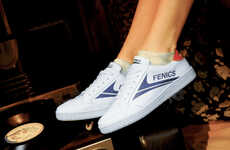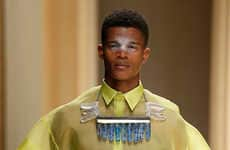
These Eco-Friendly Manolo Blahniks Utilize Sustainable Materials
Susan Keefe — November 11, 2011 — Eco
References: graziadaily & bornrich
There is no reason you can't be fashionable while still treating the planet right, and these dazzling eco-friendly Manolo Blahniks prove it. The celebrated Spanish shoe designer collaborated with the US-based Marcia Patmos to create a line of eco-friendly sandals and heels. Utilizing highly sustainable materials such as tilapia skin, raffia and cork, the duo has crafted some astounding pieces.
This is the first time tilapia fish skin has been used in fashion, but it was quite an intelligent selection. Normally discarded by-product of the food industry, tilapia skin has been put to use to deck out these sumptuous kicks. These classy Manolo Blahniks retail for $895 a pair and are currently only available in the US.
Sure to catch the eye of any moneyed fashionista in the vicinity, these eco-friendly Manolo Blahniks are both fashionable and sustainable.
This is the first time tilapia fish skin has been used in fashion, but it was quite an intelligent selection. Normally discarded by-product of the food industry, tilapia skin has been put to use to deck out these sumptuous kicks. These classy Manolo Blahniks retail for $895 a pair and are currently only available in the US.
Sure to catch the eye of any moneyed fashionista in the vicinity, these eco-friendly Manolo Blahniks are both fashionable and sustainable.
Trend Themes
1. Sustainable Fashion - Creating fashion items using highly sustainable materials such as tilapia skin, raffia, and cork presents an opportunity for disruptive innovation in the fashion industry.
2. Collaborative Design - Successful collaborations between renowned designers like Manolo Blahnik and Marcia Patmos can lead to the creation of innovative and eco-friendly fashion items.
3. Utilization of By-products - Repurposing discarded by-products of the food industry, such as tilapia skin, in fashion items offers a chance for disruptive innovation and sustainable practices.
Industry Implications
1. Fashion - The fashion industry can capitalize on the demand for sustainable fashion items and collaborate with designers to create innovative and eco-friendly products.
2. Textile - The textile industry can explore the use of alternative, sustainable materials like raffia and cork in fabric production, enabling the creation of eco-friendly fashion items.
3. Food - The food industry can explore partnerships with fashion designers to repurpose by-products like tilapia skin, turning waste into valuable materials for the fashion industry.
1.3
Score
Popularity
Activity
Freshness























